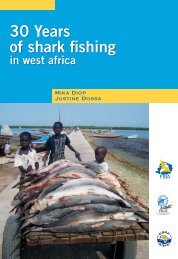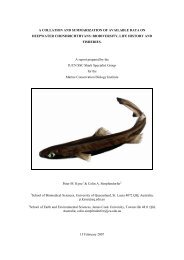Magazine of the species survival Commission specialist Group - IUCN
Magazine of the species survival Commission specialist Group - IUCN
Magazine of the species survival Commission specialist Group - IUCN
Create successful ePaper yourself
Turn your PDF publications into a flip-book with our unique Google optimized e-Paper software.
<strong>specialist</strong> group exchange<br />
action, however, encounters many<br />
problems, including many political<br />
obstacles, both within and between <strong>the</strong><br />
range countries. Trans-boundary<br />
cooperation is crucial, as leopards<br />
mainly occur in border areas.<br />
The Russian Academy <strong>of</strong> Science<br />
and WWF Russia plan to re-introduce<br />
<strong>the</strong> leopard to <strong>the</strong> north-western<br />
Caucasus. Leopards from zoos or from<br />
<strong>the</strong> wild will be bred in large enclosures<br />
with natural prey, and <strong>of</strong>fspring will be<br />
raised under almost natural conditions<br />
and released. Recently, <strong>the</strong> Russian<br />
Federation traded two Persian<br />
Leopards from I.R. Iran for two Siberian<br />
Tigers; <strong>the</strong>se leopards are now in <strong>the</strong><br />
Sochi re-introduction facility, toge<strong>the</strong>r<br />
with two specimens from Turkmenistan.<br />
Many aspects <strong>of</strong> <strong>the</strong> approach were<br />
criticised, e.g. <strong>the</strong> project was said to<br />
be a fig leaf for <strong>the</strong> Sochi Olympic<br />
winter games. However, Russia and<br />
Iran are working toge<strong>the</strong>r, and <strong>the</strong><br />
Strategy will be ra<strong>the</strong>r meaningless<br />
without <strong>the</strong> support <strong>of</strong> <strong>the</strong>se two<br />
countries. It is unlikely that leopards in<br />
<strong>the</strong> Caucasus will survive without local<br />
re-introduction and restocking, and <strong>the</strong><br />
Russian project could provide valuable<br />
experience for <strong>the</strong> re-introduction <strong>of</strong> this<br />
<strong>species</strong>. Of utmost importance will be<br />
<strong>the</strong> conservation <strong>of</strong> <strong>the</strong> source<br />
population in north-eastern Iran. The<br />
leopard discussion group at <strong>the</strong> IBA in<br />
Tbilisi concluded that <strong>the</strong>re is no<br />
alternative to cooperation between all<br />
six range countries, and that <strong>the</strong><br />
Russian re-introduction project and <strong>the</strong><br />
conservation <strong>of</strong> <strong>the</strong> source population<br />
in Iran should become an integral part<br />
<strong>of</strong> <strong>the</strong> Strategy.<br />
Urs Breitenmoser<br />
Co-Chair, Cat Specialist <strong>Group</strong><br />
Caucasus Plant RLA<br />
First comprehensive list <strong>of</strong><br />
Caucasus plant endemics compiled<br />
With support from <strong>the</strong> Critical<br />
Ecosystem Partnership Fund (CEPF), <strong>the</strong><br />
Coordination and Development <strong>of</strong> Plant<br />
Red List Assessments for <strong>the</strong> Caucasus<br />
Biodiversity Hotspot project was<br />
implemented by <strong>IUCN</strong> in collaboration<br />
with <strong>the</strong> Missouri Botanical Garden,<br />
USA, <strong>the</strong> WWF Caucasus Programme<br />
Office, and botanists from all six<br />
Caucasian Mountain Ash (Sorbus caucasigena). © O. Abdaladze<br />
countries <strong>of</strong> <strong>the</strong> Caucasus (Armenia,<br />
Azerbaijan, Georgia, Iran, Russia, and<br />
Turkey) from 2006 to 2009. The project<br />
aimed to provide a series <strong>of</strong> Red List<br />
training and validation workshops<br />
specifically tailored to <strong>the</strong> Caucasus<br />
region so that local botanists could use<br />
internationally accepted methods for<br />
plant conservation assessments and<br />
monitoring (<strong>the</strong> <strong>IUCN</strong> Red List<br />
Categories and Criteria) and <strong>the</strong> Species<br />
Information Service (SIS) as a tool for<br />
data management and analysis. The<br />
work has resulted in a comprehensive<br />
overview <strong>of</strong> <strong>the</strong> distribution and<br />
conservation status <strong>of</strong> <strong>the</strong> endemic plant<br />
<strong>species</strong> <strong>of</strong> <strong>the</strong> Caucasus region based<br />
on current knowledge.<br />
The Caucasus Plant Red List<br />
Authority was established under <strong>the</strong><br />
<strong>IUCN</strong> Species Survival <strong>Commission</strong><br />
within <strong>the</strong> framework <strong>of</strong> <strong>the</strong> above<br />
project. A series <strong>of</strong> Red List workshops<br />
successfully introduced participants to<br />
<strong>the</strong> <strong>IUCN</strong> Red List process and<br />
highlighted <strong>the</strong> use and relevance <strong>of</strong><br />
assessments for conservation planning,<br />
with <strong>the</strong> subsequent development <strong>of</strong> a<br />
regional Plant Conservation Strategy.<br />
Targets listed in <strong>the</strong> draft <strong>of</strong> <strong>the</strong> Plant<br />
Conservation Strategy for <strong>the</strong> Caucasus<br />
correspond to <strong>the</strong> targets <strong>of</strong> <strong>the</strong> Global<br />
Strategy for Plant Conservation, with a<br />
fur<strong>the</strong>r emphasis on monitoring and<br />
response to climate change. CEPF has<br />
been solicited for support <strong>of</strong> <strong>the</strong><br />
publication <strong>of</strong> <strong>the</strong> Strategy in 2011, to<br />
be titled <strong>the</strong> Caucasus Plant<br />
Conservation Initiative.<br />
Data collected for <strong>the</strong> <strong>species</strong><br />
assessments resulted in <strong>the</strong> first<br />
comprehensive list <strong>of</strong> plants endemic to<br />
<strong>the</strong> Caucasus region (ca. 2,750 <strong>species</strong>/<br />
sub<strong>species</strong>). Red List assessments <strong>of</strong><br />
ca. 1,200 taxa were conducted,<br />
including all national endemics, with ca.<br />
60% assessed as threatened. The final<br />
product <strong>of</strong> <strong>the</strong> project, The Red List <strong>of</strong><br />
Endemic Plants <strong>of</strong> <strong>the</strong> Caucasus Region,<br />
with <strong>the</strong> full list <strong>of</strong> endemic plant taxa <strong>of</strong><br />
<strong>the</strong> region and <strong>species</strong> assessments, is<br />
planned for publication in 2011; <strong>the</strong><br />
assessments will also be published on<br />
<strong>the</strong> <strong>IUCN</strong> Red List website.<br />
Ketevan Batsatsashvili<br />
Programme Officer, Caucasus Plant<br />
Red List Authority<br />
Cetacean SG<br />
Saving <strong>the</strong> river dolphins<br />
A symposium and workshop on<br />
protected areas for Asian freshwater<br />
Irrawaddy Dolphin (Orcaella brevirostris).<br />
© Danielle Kreb<br />
16 • <strong>species</strong> 52
















